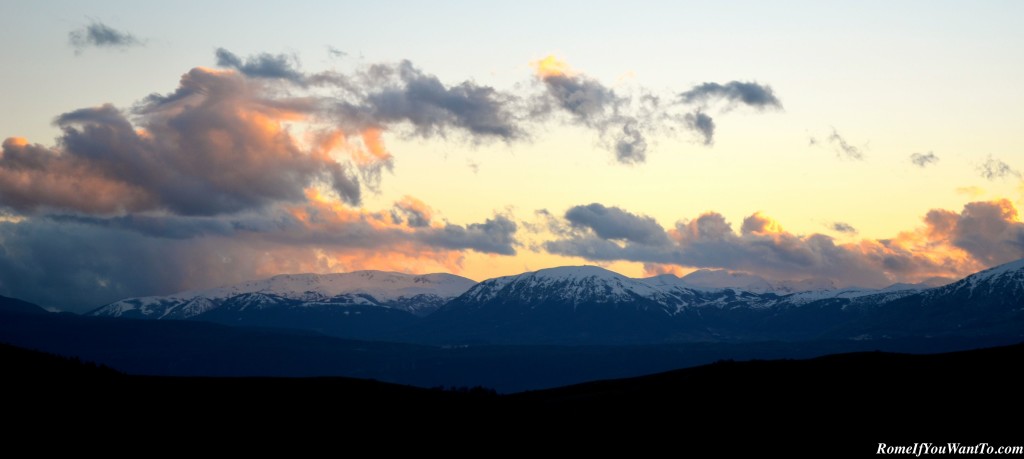
Sky, clouds, mountains, hard to believe less than two hours from the chaos of Rome.
A short drive from Rome – less than two hours – sits Santo Stefano di Sessanio, a medieval hill town with a permanent population in the very low hundreds. Santo Stefano is located in the very highest section of the rocky, snowy Apennine mountains, and inside an Italian national park.
Frankly, I’ve lived in Rome a long time and had no idea such a pristine mountain hamlet was only a couple of hours away. When we – you, me, almost everyone – think of excursions from Rome, we think of Tuscany, don’t we? Or the Amalfi Coast? Or, if you don’t have much time, the beaches around Rome like Ostia and Fregene.
But give Abruzzo a second look.
I hadn’t been in this central Italian region since long ago 1999, when I went to Pescara on the Adriatic coast. Pretty forgettable, I’m sorry to say, with nondescript mid-century buildings lining a mediocre beach. I remember I had a bad allergy attack thanks to some moldy hotel blankets, and that’s about it. But I had always heard that Abruzzo rocked some major mountain views and fresh air and so I’d always intended on checking it out.
A colleague from L’Aquila, Abruzzo’s capital, suggested Santo Stefano di Sessanio, and it’s completely unique and amazing Albergo Diffuso in Sextantio. This “Diffused Hotel” has its bedrooms, restaurants, and other public areas scattered throughout the village and there is really no reason to consider staying anywhere else in Santo Stefano, or maybe even the world. More on that later.
A moment ago I said that the village is pristine. Not quite. One stark blemish is the Medici Tower, looming over the village since the 14th century, which crumbled tragically in the 2009 L’Aquila earthquake. That tragic quake killed about 300 people, but became even more famous due to its bizarre aftershock: in 2012, six seismologists were found guilty of manslaughter for failing to predict the earthquake. I wrote a joke about that here, because jokes are one way we try to make sense of nonsensical things. One of the convicted scientists explained, “it was a very Italian and medieval decision.”
And then there is this tower. What a shame. For five years now it has been in the state you see in the photographs. I asked some locals what was taking so long and they laughed and said, “There is no money. What little money there is, is going to re-build residential areas of L’Aquila.” I had driven by L’Aquila on the way to Santo Stefano. The skyline is still crowded with cranes.
I am glad, though, that at least the metal structure of the tower has been built, so visitors can see the shape, size, and location of the Tower, which should one day rise again.
Forget the tower – the rest of the village is something to behold. A maze of cobblestone streets that intersect, diverge, go up, go down, run parallel and then perpendicular, and offer mountain views around every corner, duck under dozens and dozens of centuries-old archways. Little bottegas are everywhere. Orange light oozes out of windows and smoke puffs out of chimneys. There is little to do but walk around, deeply inhale fresh air, take pictures, and consume wonderful things.
Some photographs of Santo Stefano in Sessanio, Abruzzo, Italy:
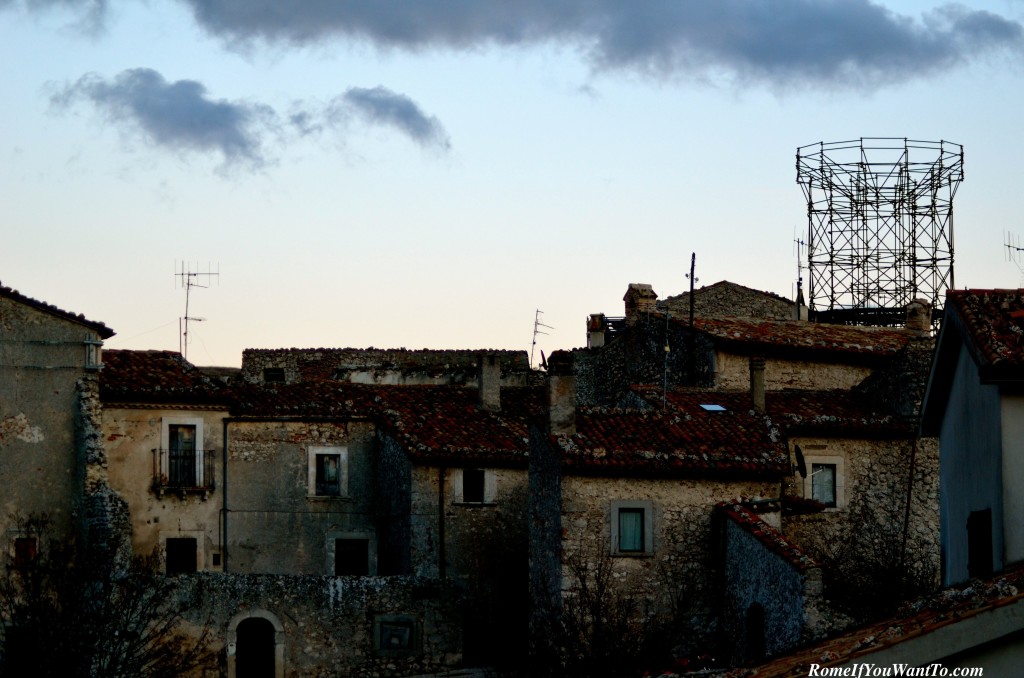
The missing Medici tower. Sorry, but with all the taxes Italians pay (up to 60% on income), I’m sure they’d like to see some more progress here five years after the quake.
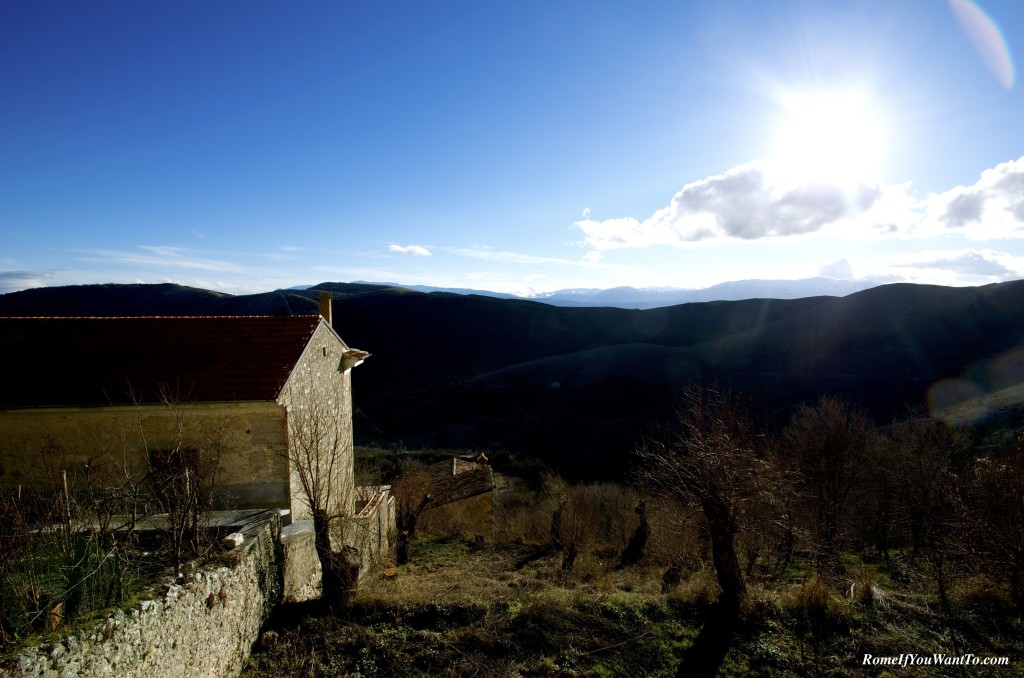
Mountain, and sky, views around every corner.

Santo Stefano di Sessanio
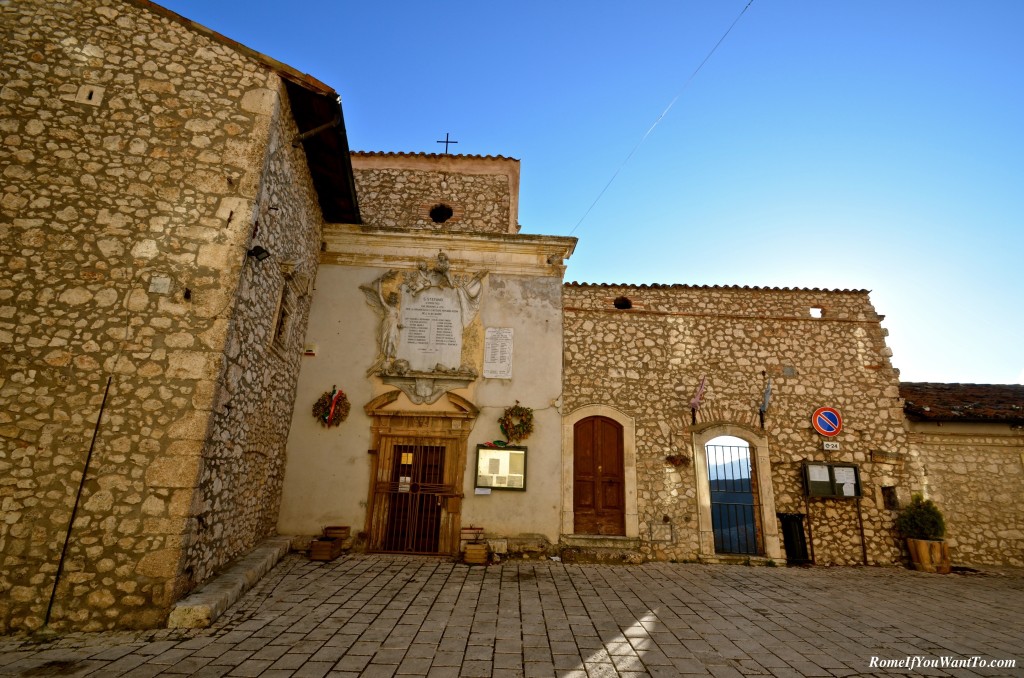
What’s an Italian town without a church?
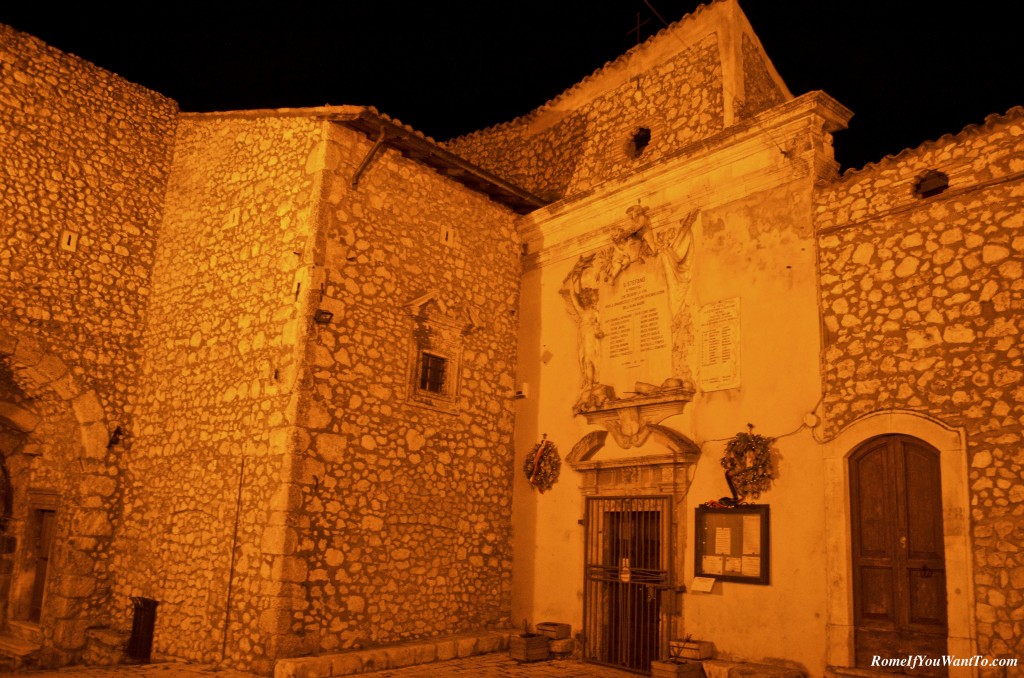
The same church, at night.
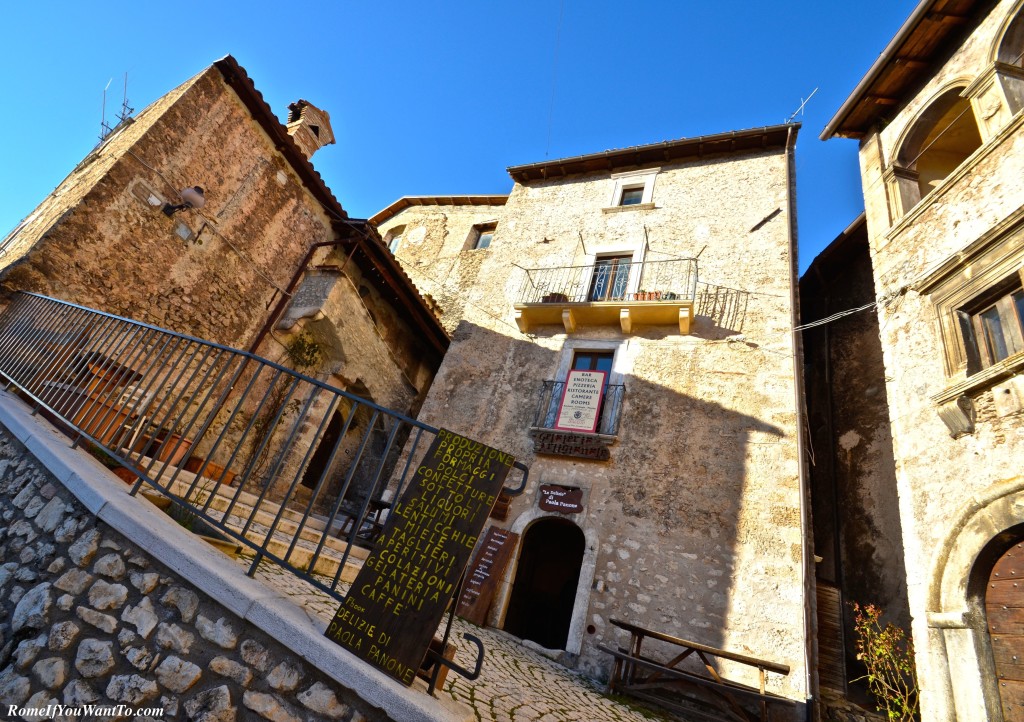
Santo Stefano di Sessanio
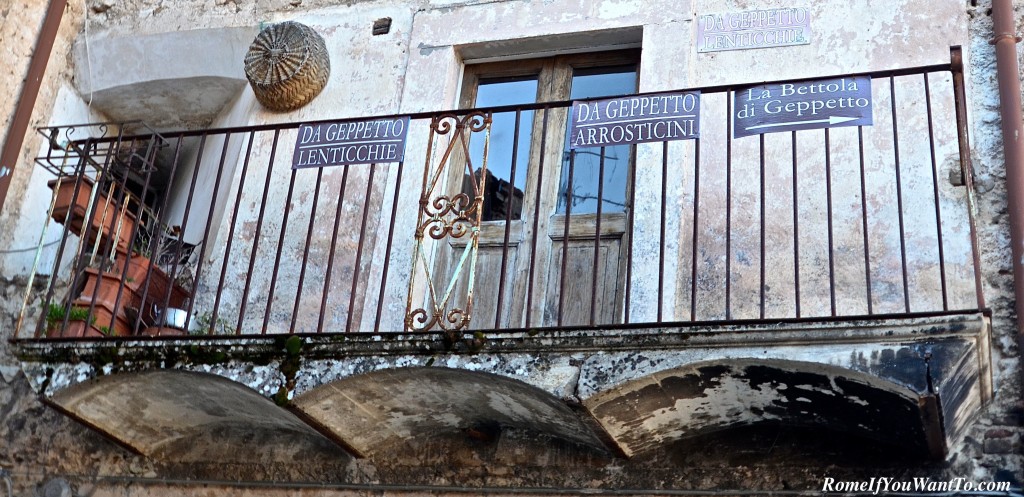
Geppetto must be very busy.
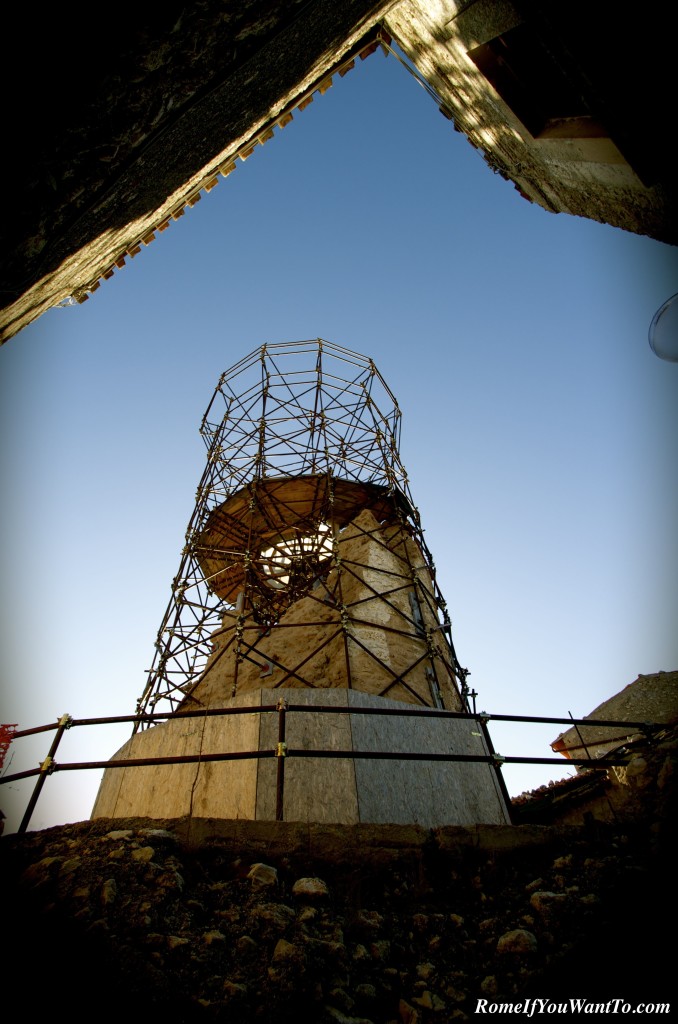
The 16th-century Medici tower, which collapsed in the 2009 earthquake. Restoration is slow due to shortage in funds.
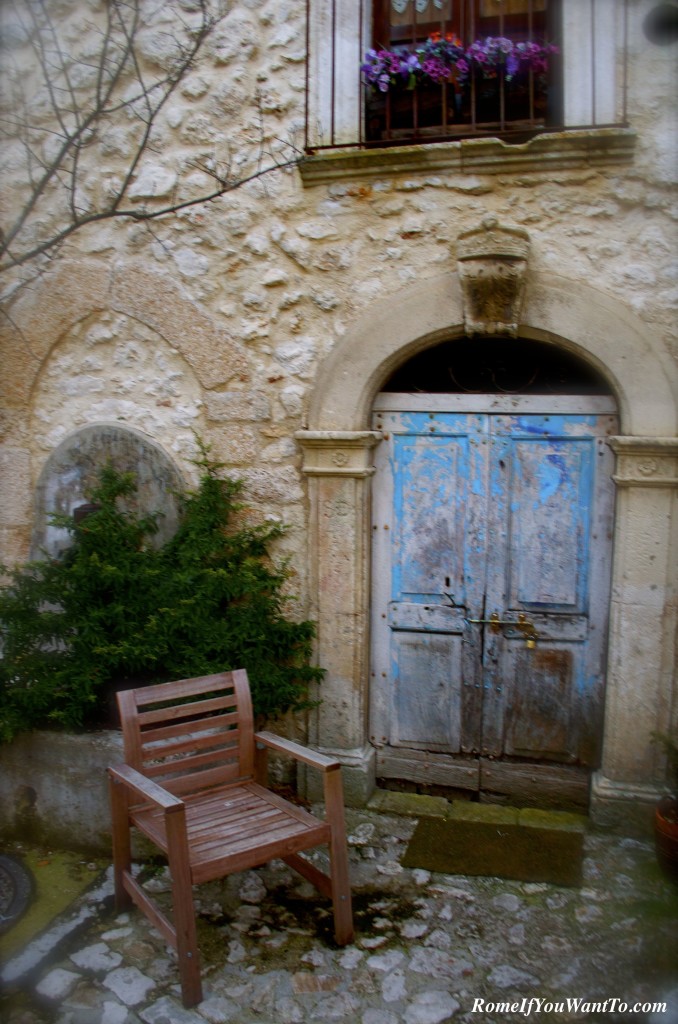
Little splashes of color in an otherwise monochrome stonescape.
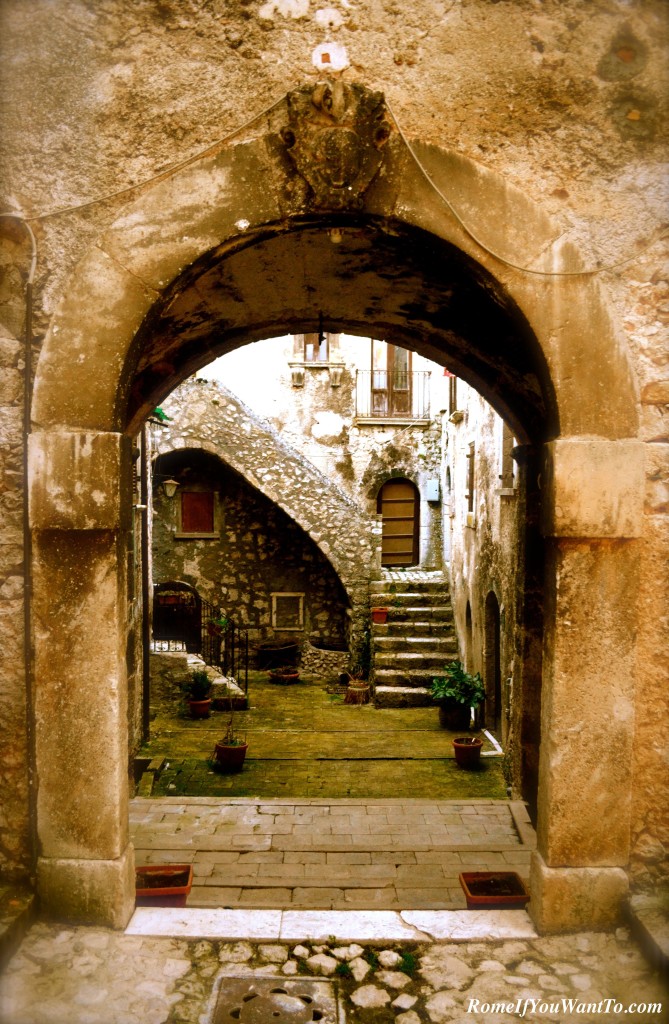
Santo Stefano di Sessanio is famous for its archways.
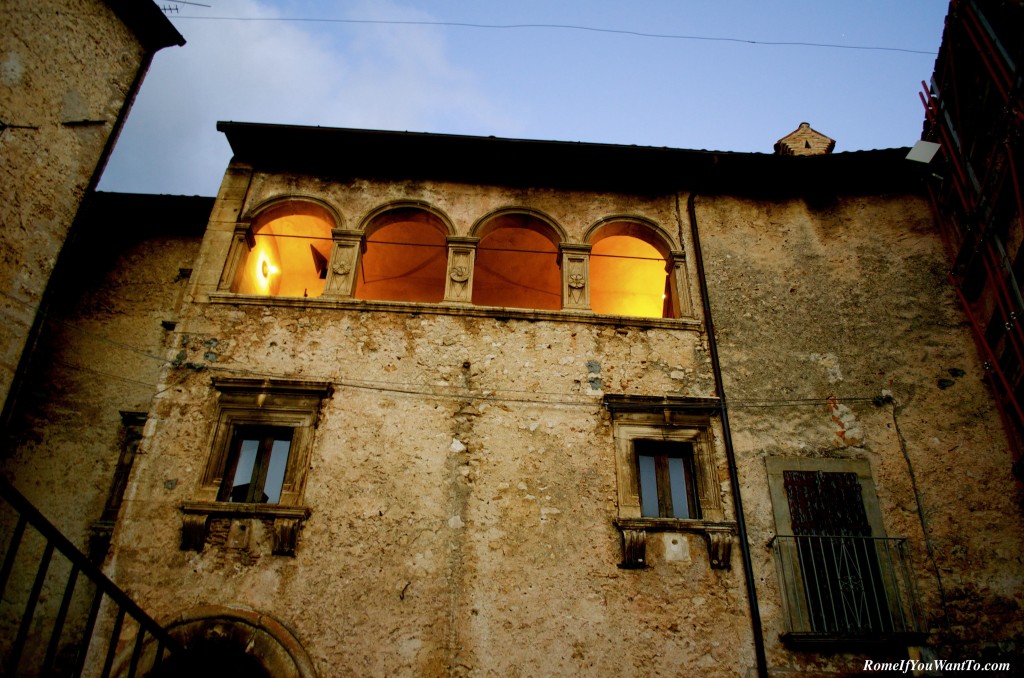
At dusk, the windows light up orange. Outside was cold and inside looked so cozy, you just had to go in and order something hot.
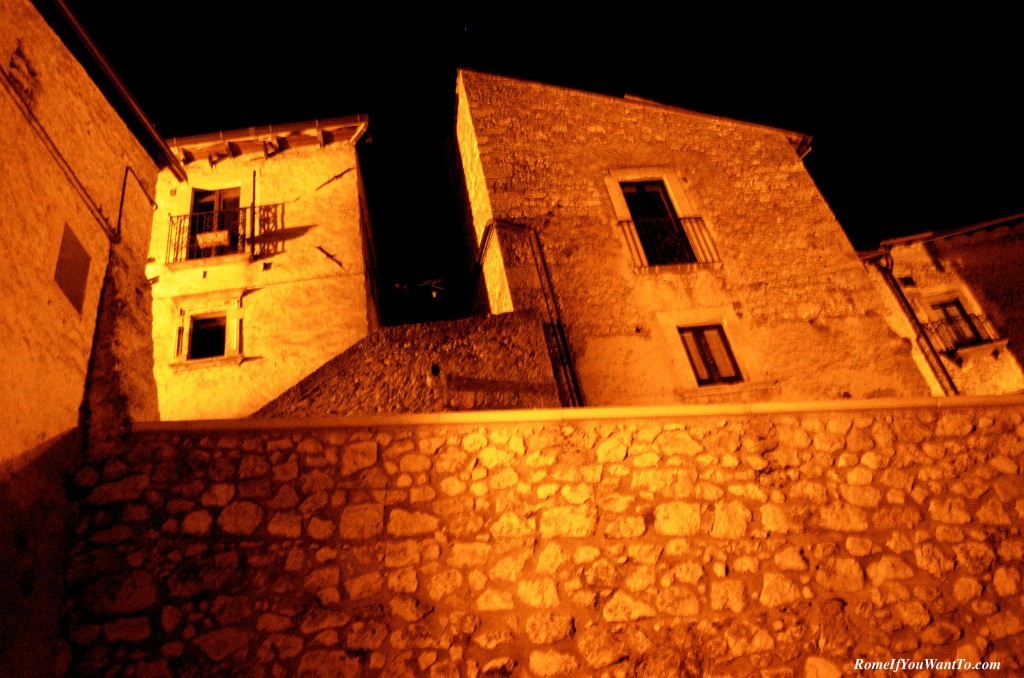
Santo Stefano at night.
WHERE TO STAY:
Where to stay? The Albergo Diffuso di Sextantio, that’s where. When you check in to the “Diffused Hotel,” you are given a map that will show you how to get to your room, which is in some other structure in the village. And from there, how to get to the restaurant, the cantina, the tea house, and other shops. It is more of an experience than a hotel. I had a three-room suite with two working fireplaces (the hotel leaves you kindling and wood) and a bathtub in the bedroom. Glass bottles of shampoo and soaps, bottles of cold water, and even a bottle of grappa were provided. Back when I was practicing law in America, I stayed at some mighty fancy places during my travels, and I will go so far as to say that this was the nicest room I have ever had in any hotel in my life.
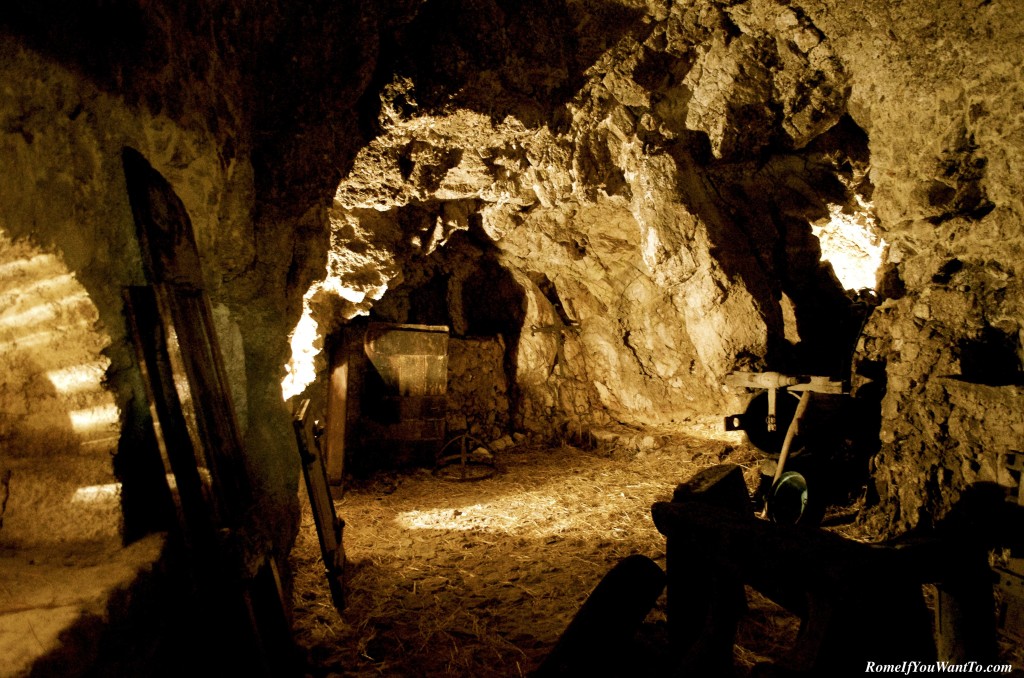
Reception of the Albergo Diffuso di Sextantio, Santo Stefano in Sessanio, Abruzzo
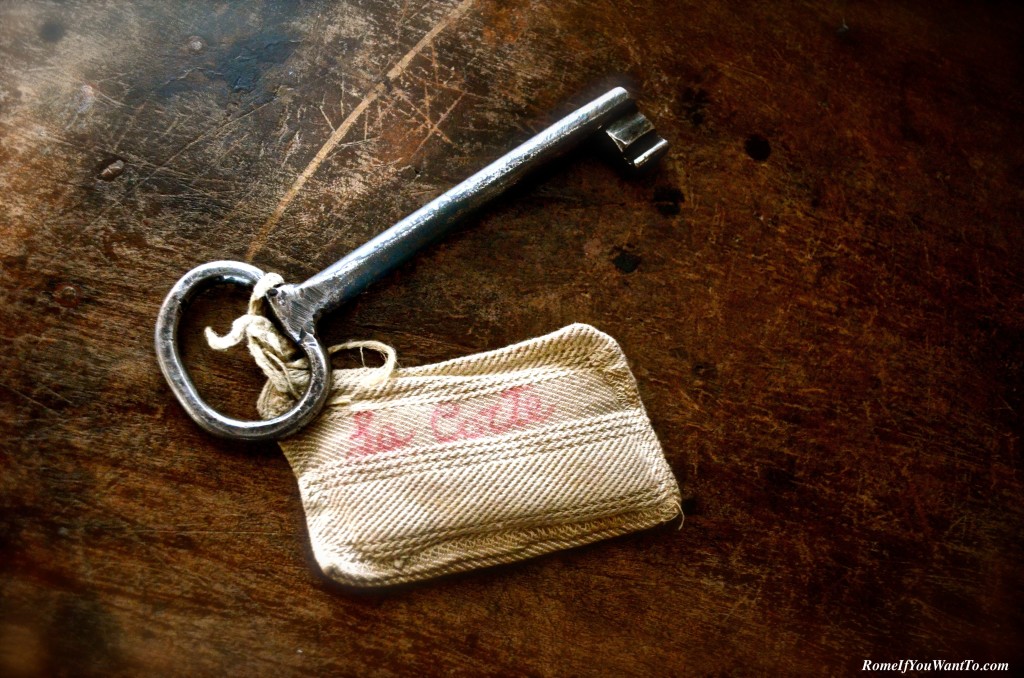
The actual room key to my suite. I almost overdosed on charm.
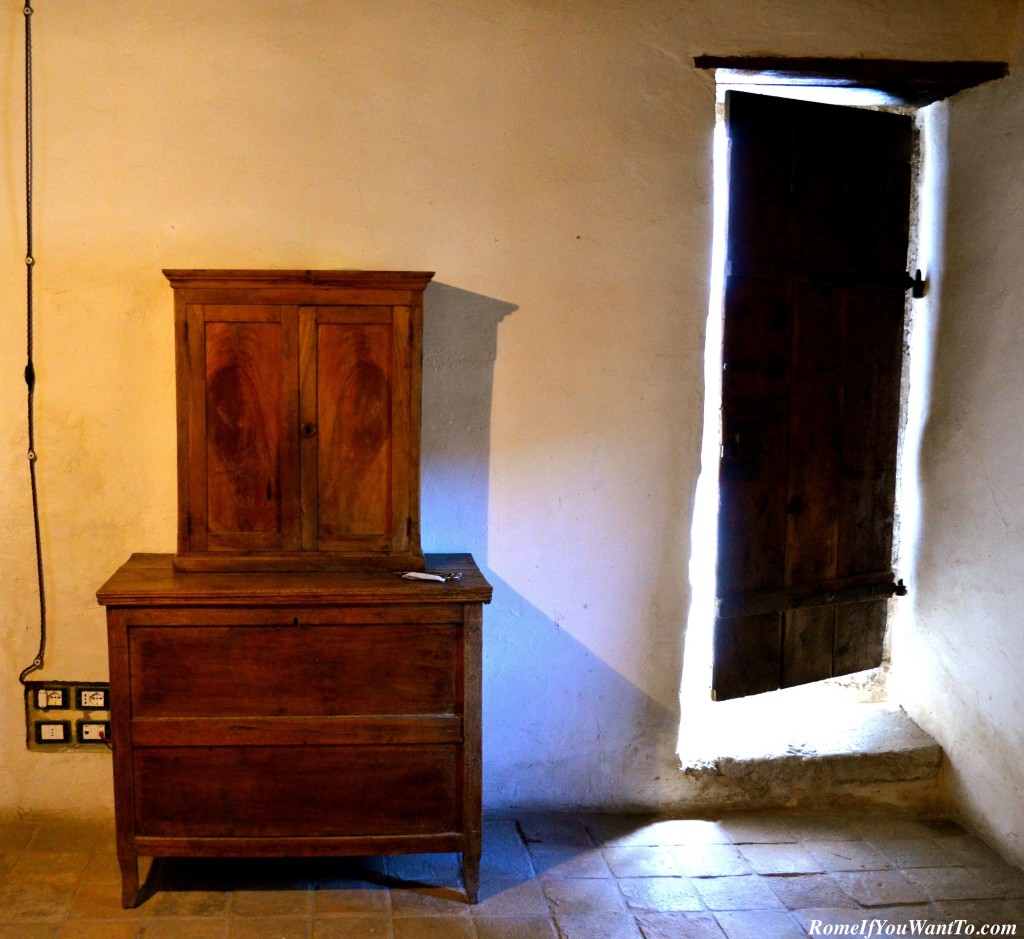
The entrance to my three-room suite is that old wooden door on the right.
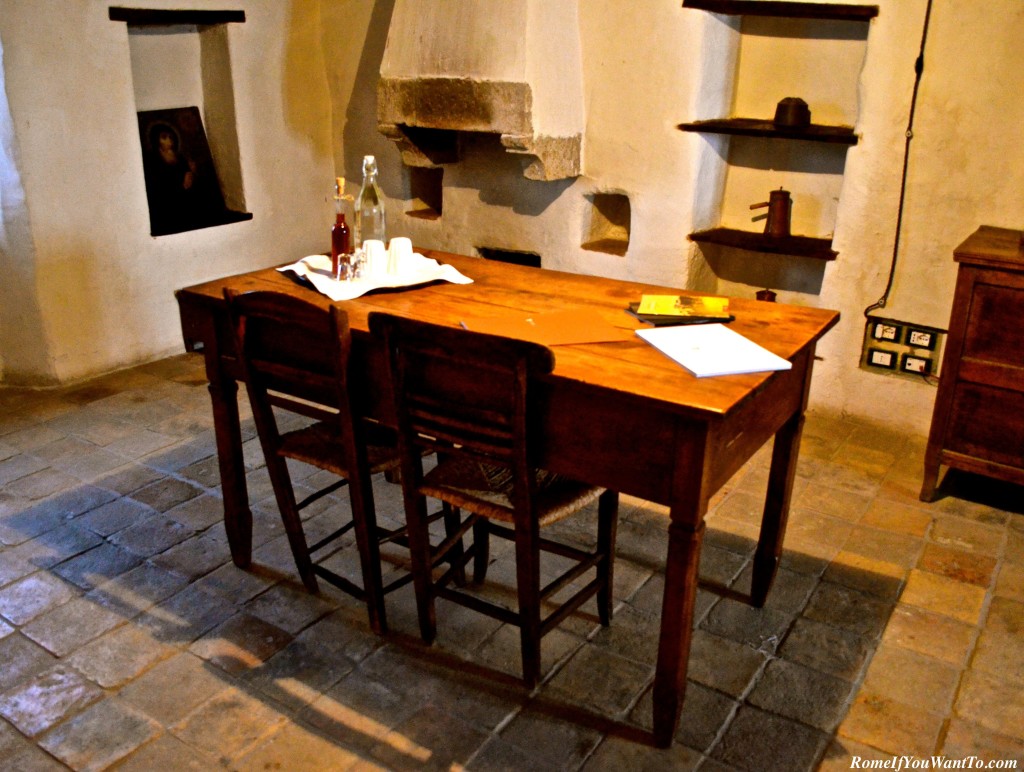
The dining room of my suite at the Albergo Diffuso di Sextantio.
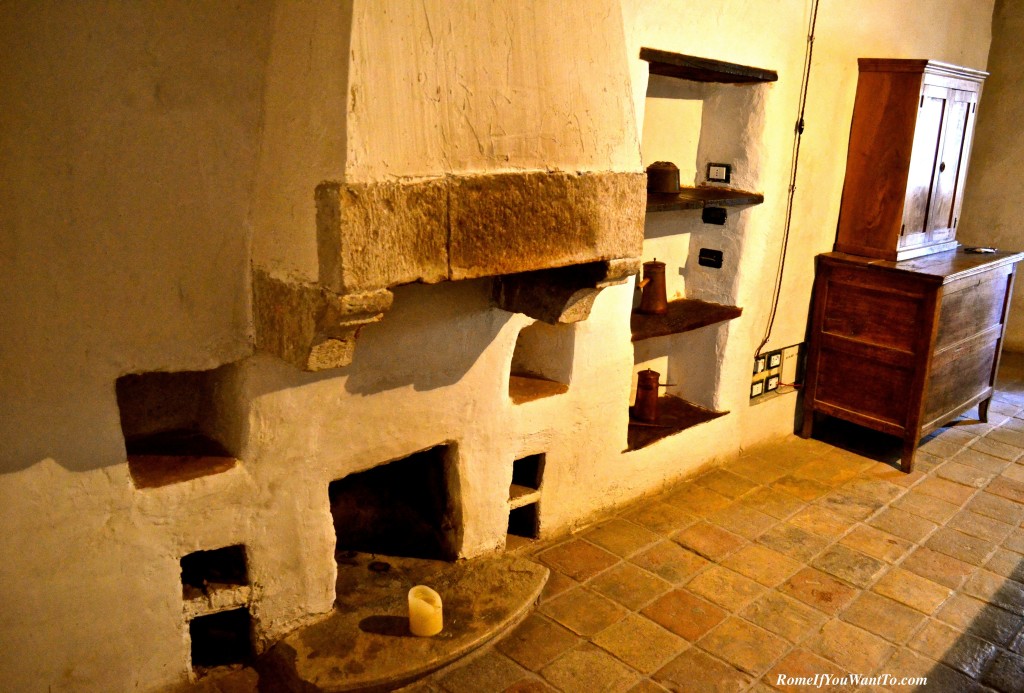
One of my two fireplaces; this stunning wall ran along the dining room in my suite.
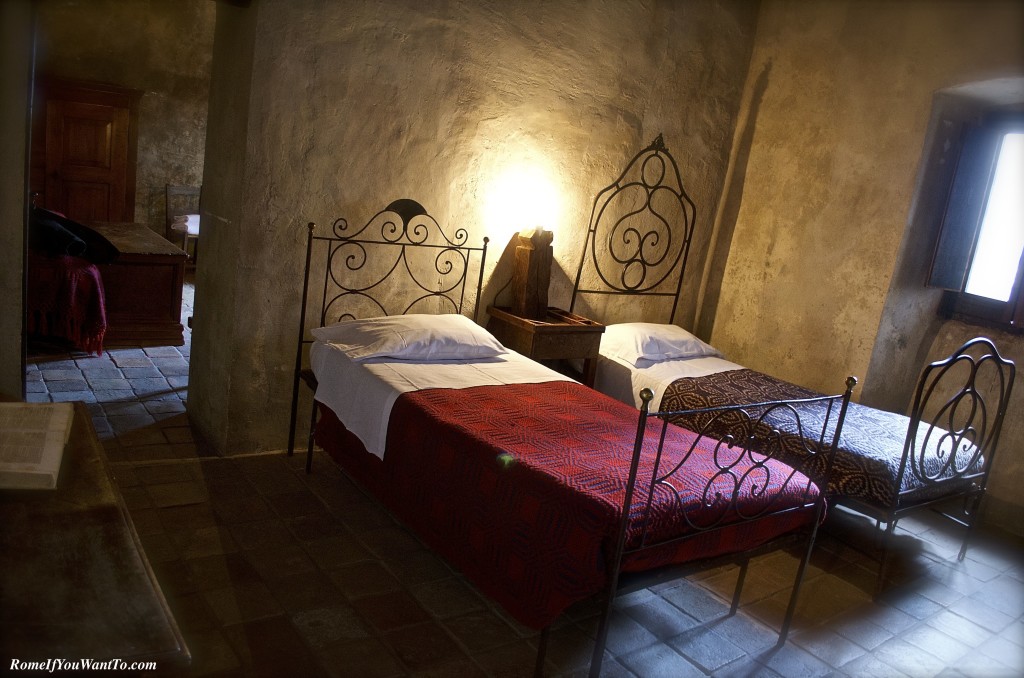
My three-room suite included a twin bedroom. I thought it was a shame not to use it. Love that the beds don’t match. Swoon.
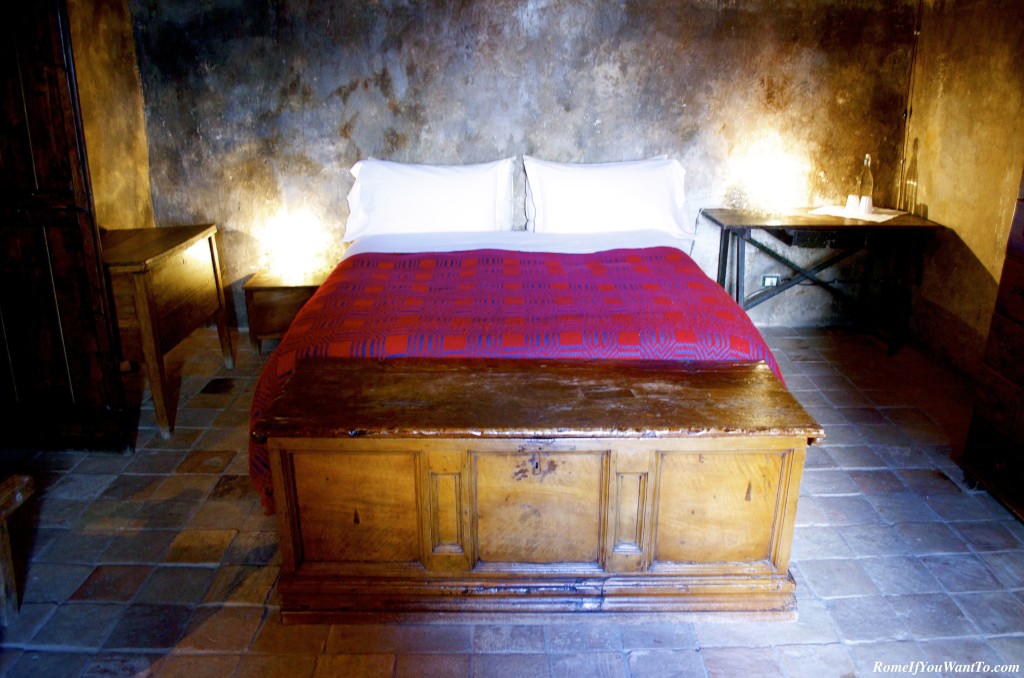
Felt like a queen in this king!
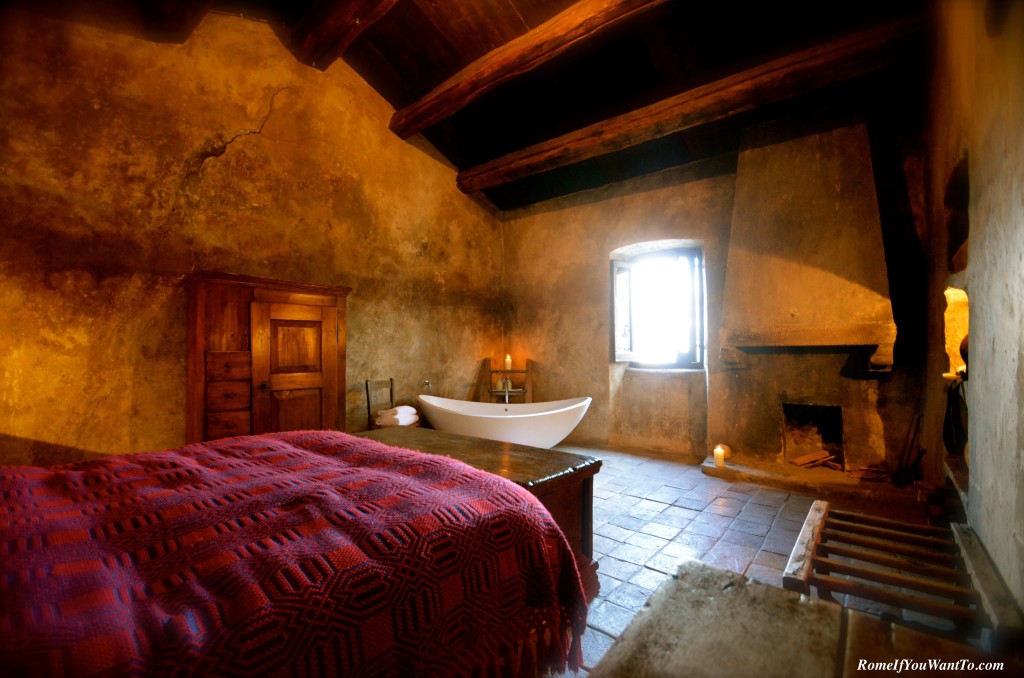
Beamed ceilings, reclaimed from the original structure and refurbished.
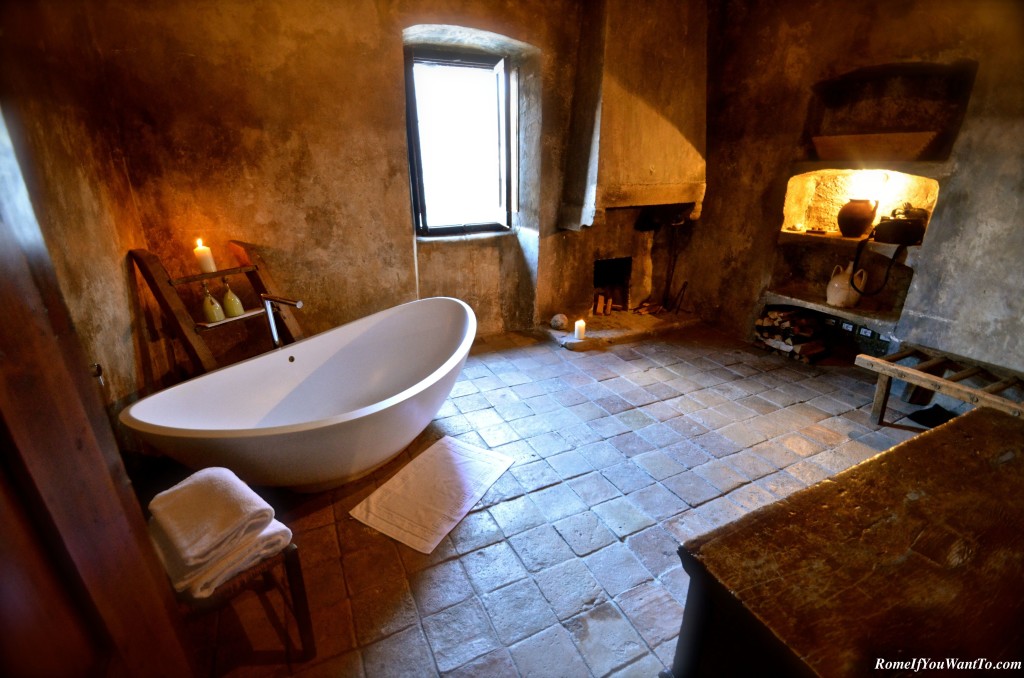
The room of my dreams, y’all. Huge tub, fireplace, heated stone floors, mountain views.
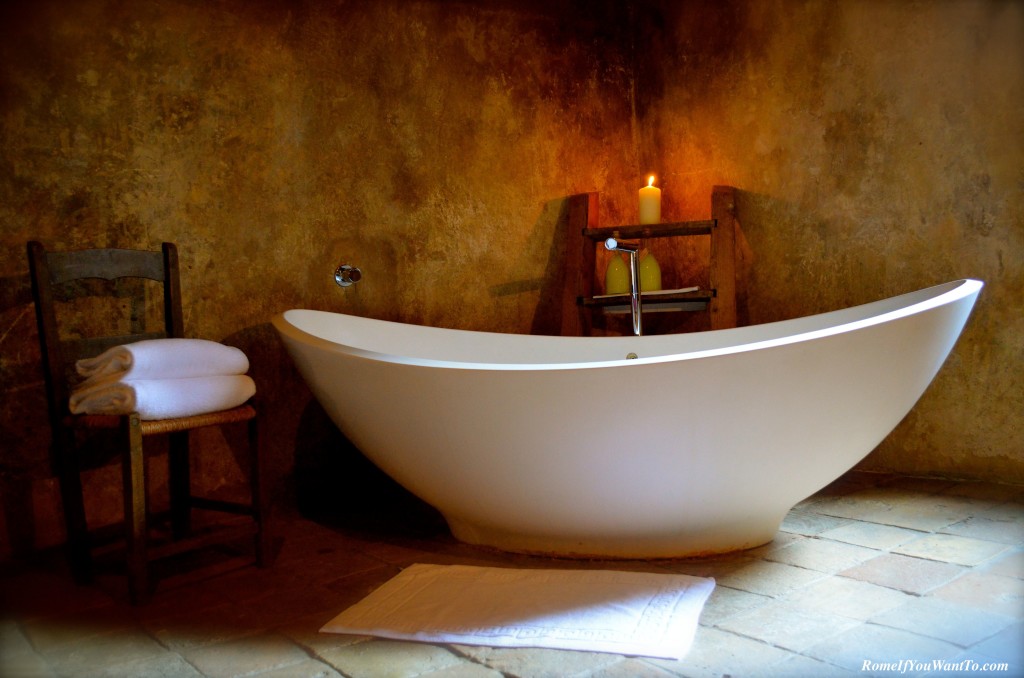
I mean, come on. Perfect.

At night. After dinner, and wine, and dessert.
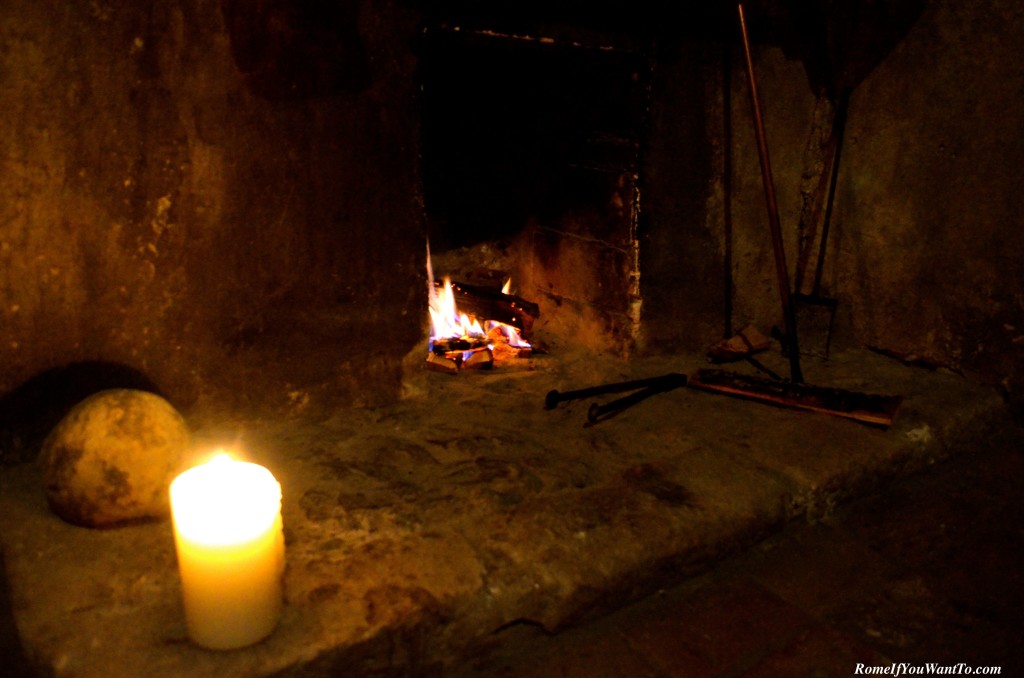
Close-up of the fire!
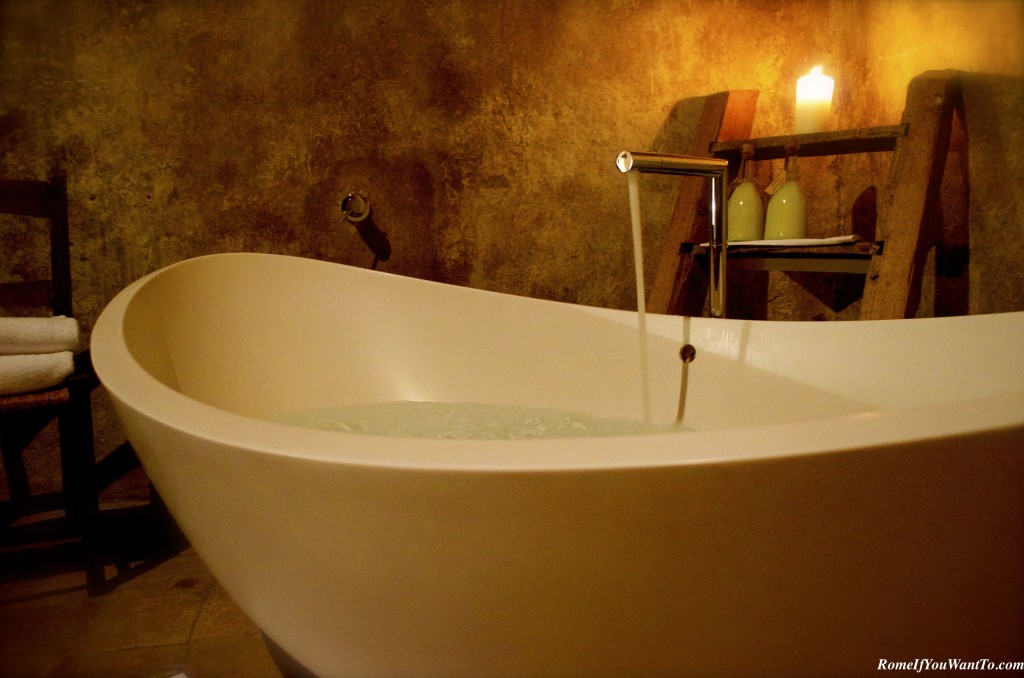
Close-up of the tub… As I’m typing this sentence I’m thinking about when I can go back there….
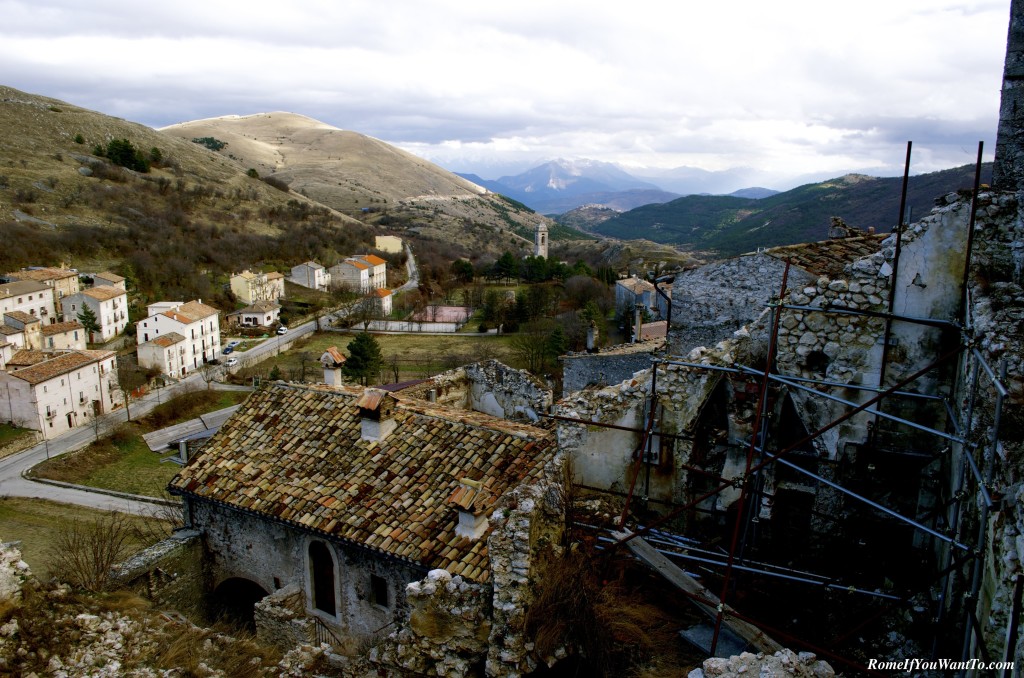
The view from my bedroom towards the Appenines. Well, other Appenines. I was already in the Appenines!
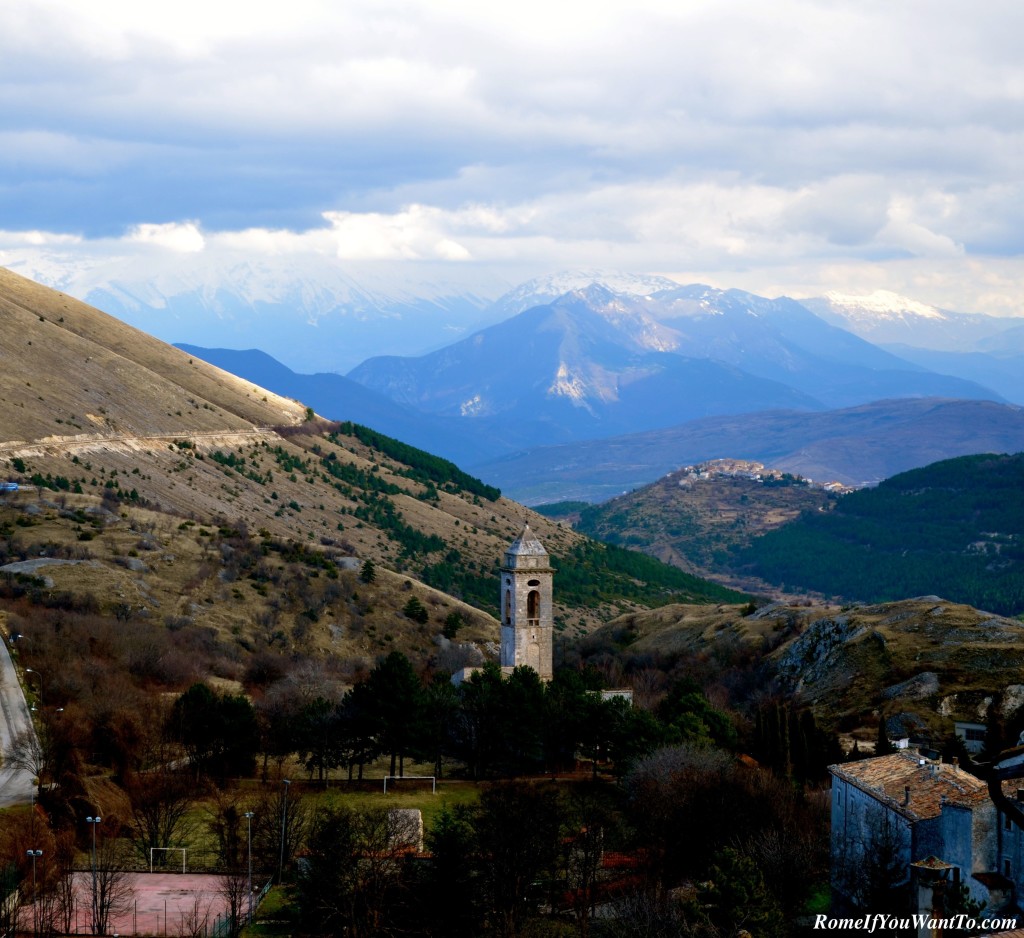
Santo Stefano in Sessanio’s Bell Tower in the distance.
WHAT TO DO:
What to do is really just walk around. I cannot say enough about the joy of sucking in fresh air when you live in a place like Rome. And the sky is so multi-chromatic and the shapes and lines of the buildings and arches so contrasting that photographs take themselves.
Besides walking around, one must eat and drink. The hotel buildings, as scattered around the village as the bedroom suites, include a tea house, cantina, and restaurant. I tried all three. In the tea house you can mix and match loose teas to suit your tastes and health needs, and dunk an entire plate of cookies in your cup while you’re at it. Then head to the cantina before dinner for a bottle of earthy wine and a plate of local cheeses, meets, and compotes. This was my favorite spot in the whole village (besides the fireside bathtub, which you’ll see below). Between gulps of wine and bites of pecorino, I got to play board games, one of my favorite activities since earliest, earliest childhood.
If you have room (make sure you do), go to the restaurant for a candlelit dinner. The designer of this place deserves a major gold star for decorating everything with reclaimed agricultural tools, utensils, and even a tricycle.
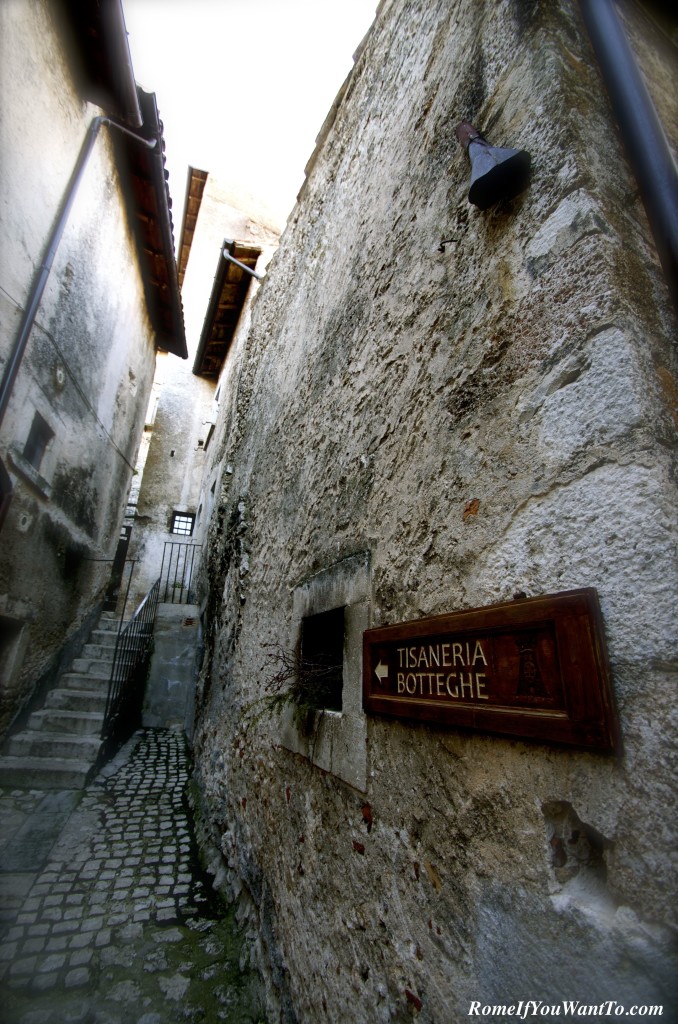
This Way to the Tea House, and Shops.

A detail in the Albergo Diffuso’s restaurant.
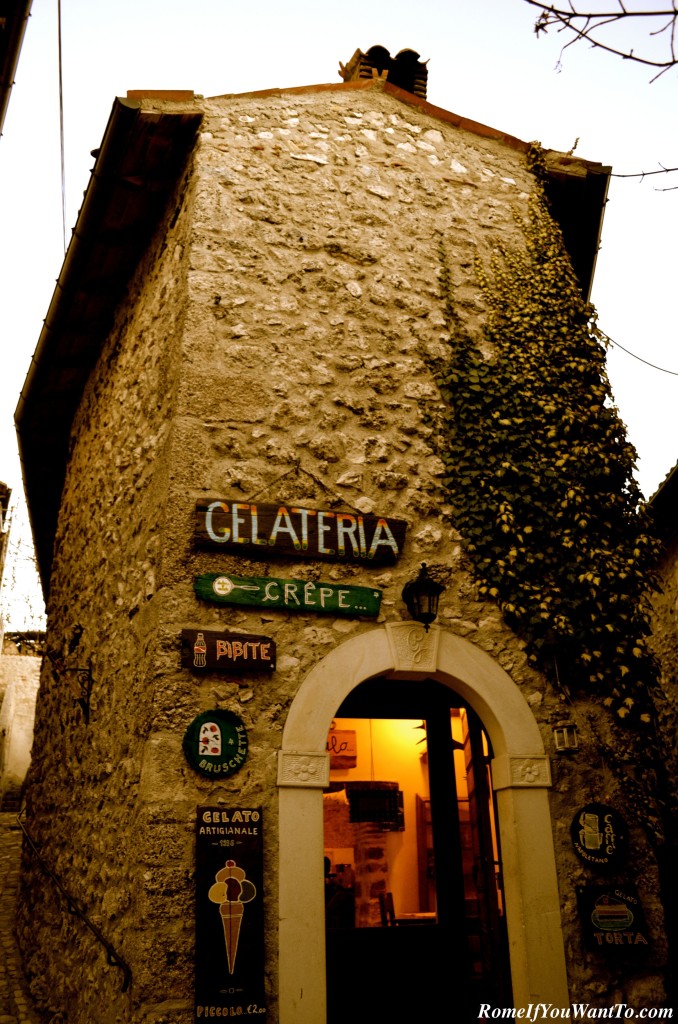
Even in the cold Abruzzo mountains: Ice cream.

Geppetto must be very busy.
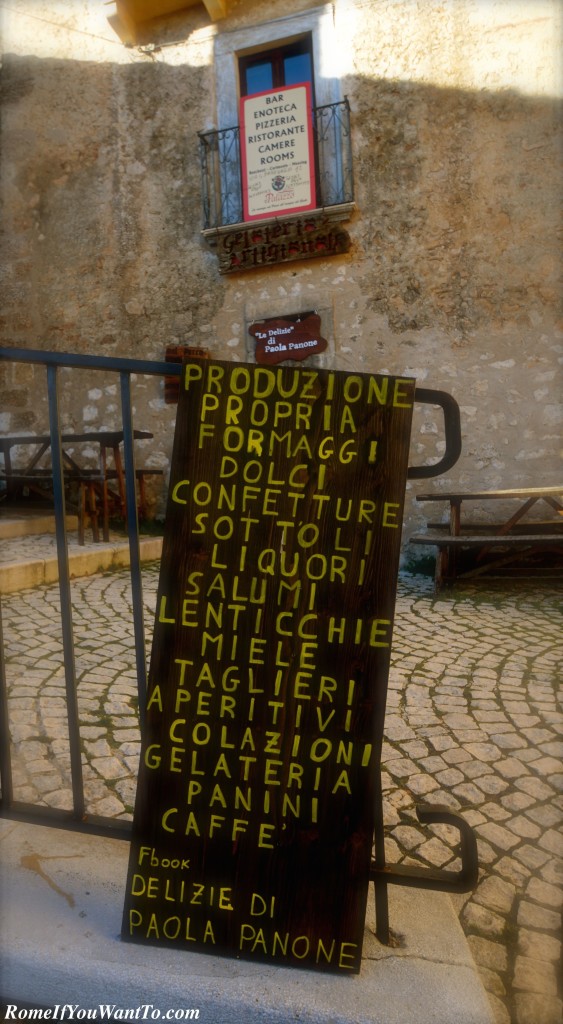
Things to do eat.
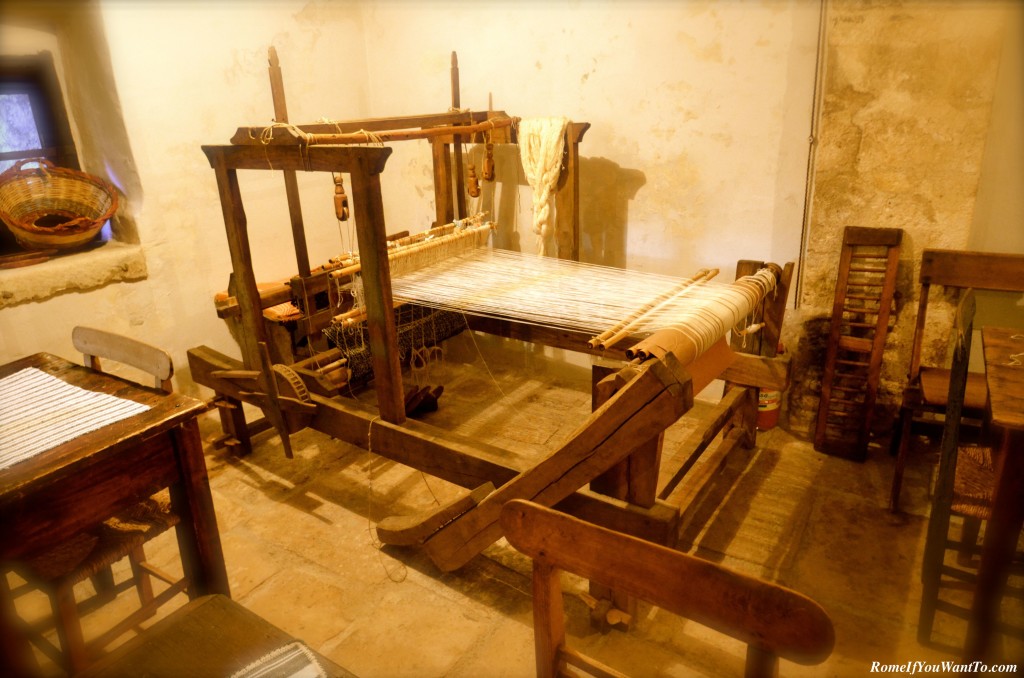
A real loom(!) in the tea house. Items made by the loom were available for purchase.
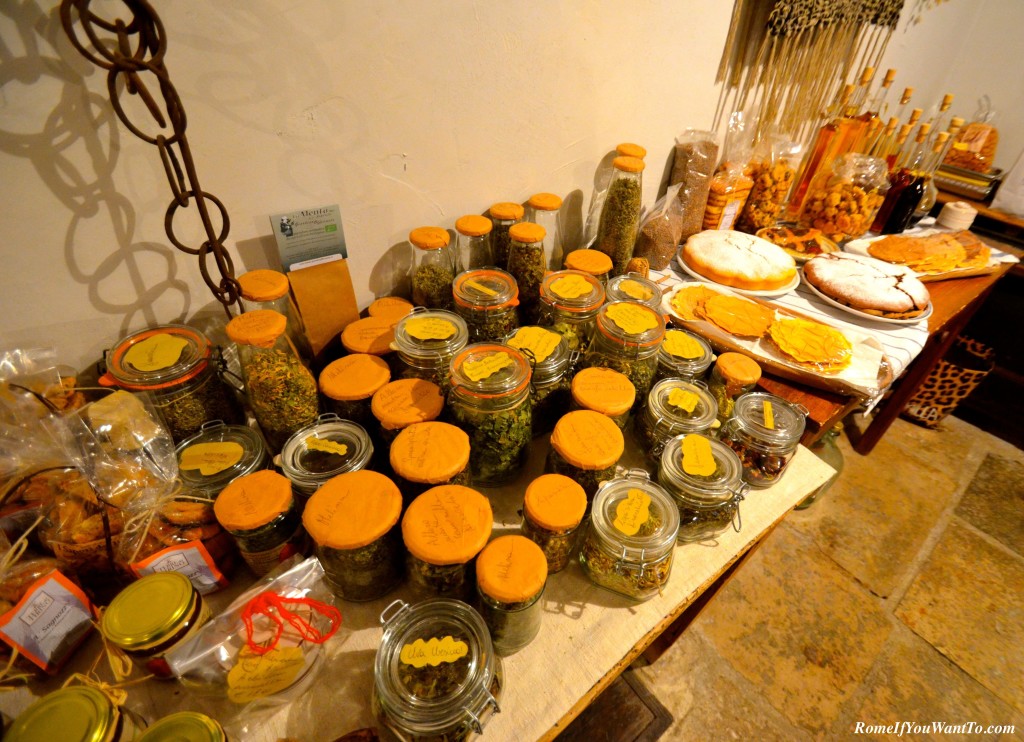
In the Albergo Diffuso’s teahouse, you could mix and match your own teas or select from pre-mixed concoctions for things like digestion, energy, urinary tract health, and others.
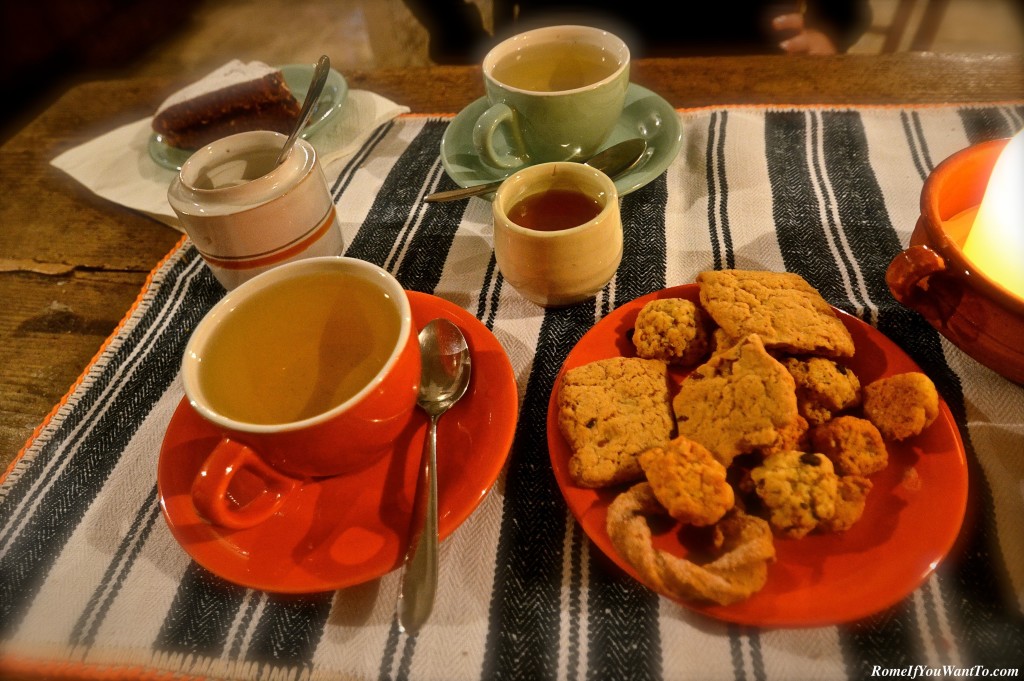
The teas we selected, brought with a plate of assorted cookies, all wonderful (I had said, “Just bring a few, whatever kind, and this is what she brought for two people), and a piece of chocolate cake. She also brought a little honey pot (center), and I sipped and nibbled by candlelight.
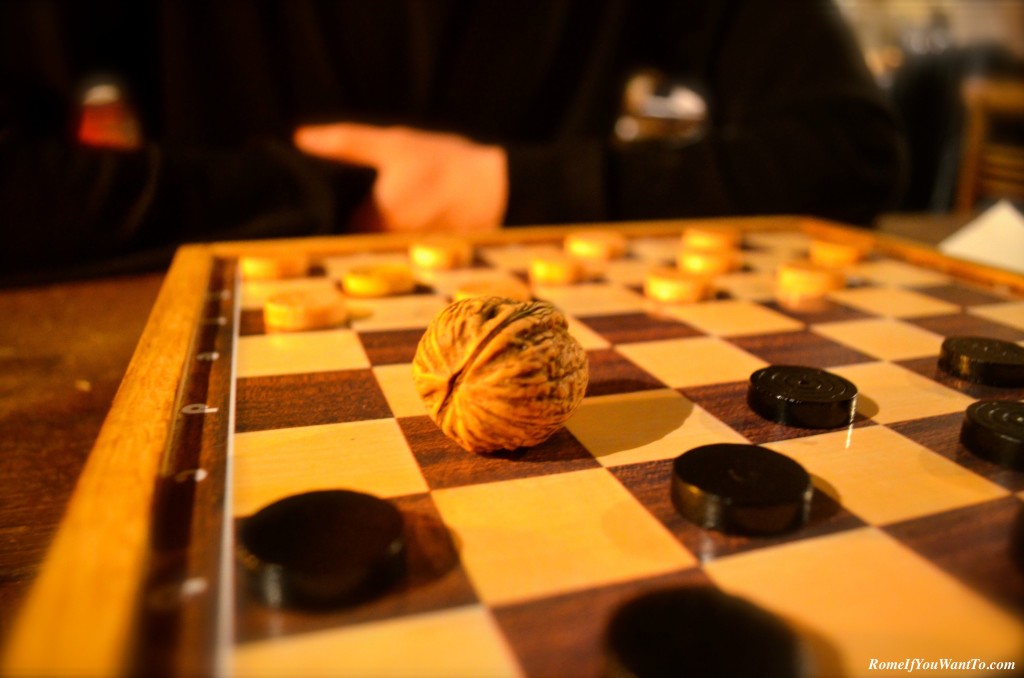
Board games in the Albergo’s Cantina. Two black pieces were missing, but I improvised. LOTS of wine and plates of cheese and ham/salami/toasted bread were consumers over checkers and Trivial Pursuit.
I imagine you are convinced!
So, getting there:
From Rome, drive in a car. It takes about an hour and 45 minutes.
If you do not own a car or can’t bum a ride with someone who does, I suggest renting one.
TIP: Consider taking the train to L’Aquila and renting a car there. You will almost certainly save money on the cost of the rental, and you will avoid the panic of driving in Rome. However, I cannot recommend this option because after about 20 minutes of searching online just now, I cannot find any big name rental car agencies within easy walking distance of the train station. Maybe you’ll have better luck than I.
If driving is out of the question, there are buses. (There is no train station in Santo Stefano). Take THIS BUS from Rome (the Tiburtina bus station, NOT Termini) to L’Aquila (make sure you get off at the AUTOSTAZIONE DI COLLEMAGGIO station) and then THIS BUS to Santo Stefano in Sextantio. Reserving tickets online beforehand seems extremely difficult if not impossible. Apparently one needs an Italian credit card, and fluency in the language. But, my friend who has taken this bus several times says there are always plenty of seats and you can buy a ticket the day of. If you get to the Tiburtina bus station in Rome (there is a metro that will take you there, Line B), just ask someone for the bus to L’Aquila and buy a ticket right there.
As you can see, driving is the best option.
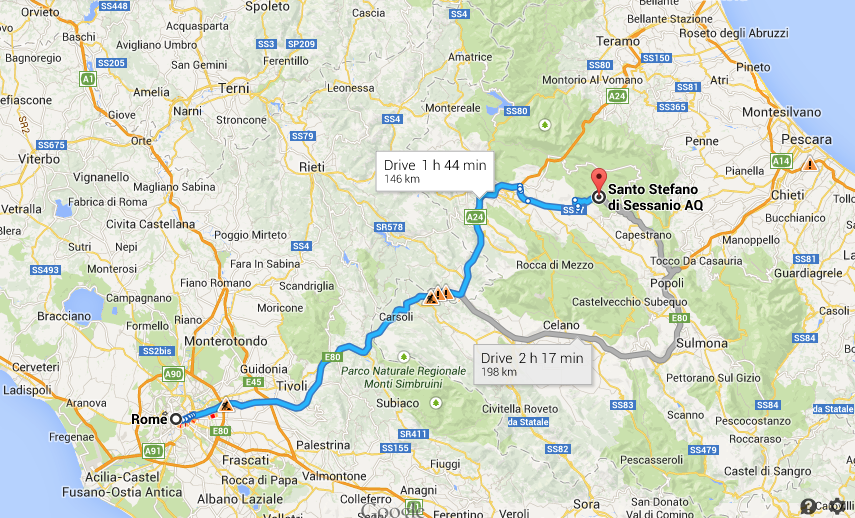
You really only need a full day (and the next morning) to enjoy the village, but do make sure you get there early and spend the night. You’ll want to spend an hour in the tea house, a couple of hours in the cantina, a couple of hours at dinner, a couple of hours in your tub, and lots of hours walking around.
Last tip: I’m sure the village is lovely in the summer, but there was something special about going in the cold. It flurried the morning I left and the sky was that wintery color. Fires were in fireplaces and hot tea seemed to make everything right in the world.
********
If you like silliness and distractions from work, or miss my Random English posts, consider liking my Facebook page for daily funnies! And why not get this blog in your email? Use the handy link below.








I live in Abruzzo and had seen the Medici tower before the collapse. It was magnificent! Santo Stefano is magic and moody off-season when it is cold and cloudy. There are also some charming villages nearby such as Castel del Monte with its delicious cheeses. The photos are stunning, thank you!
Hello and thank you for reading and writing! Lucky you; I never saw the Medici Tower, and at this rate I’m afraid I never will! I agree Santo Stefano was totally magical, and “moody” is a good word for it, too. I’ve got to check out more spots in the area, especially now that I know it’s so close and easy to get to. I think I’d drive to the end of the earth for delicious cheeses.
Thank you for the comment on my photos – I take about 1000 and hope that a few turn out nice! These ones did!
Please keep in touch. Ciao, Liz
Hello Liz
You brought tears to my eyes as I read through the blog on Santo Stefano. I visited in 2000 with my wife to be. I stayed in the area 15 glorious days. You see Liz, I had finally come home. All the stories from my childhood came alive. The graveyard displayed my family. You see my father was born there as well in 1921. I would love to share more. I want to go back so badly. I pray that I will someday be able to return. I am in my second marriage with a 9 and 6 year old and I want to show them where it all started for us.
Auguri a Tutti
Paolo Giustizia
trainingservices@execulink.com
How kind of you to write such lovely words. I appreciate your reading and taking the time to send me this note. Please stay in touch! Warmest wishes, Liz
Ciao Liz,
My name is Lauren and I am a big fan of your blog. I am fairly certain I discovered it googling something like “being an American attorney in Rome”, as I too am a travel-loving lawyer who found herself looking around the office recently saying “this can’t be my life for the next 30 years!” So, earlier this year I quit my job at the Department of Justice and moved with my boyfriend Carlo, who grew up in Calabria, to Miami (my adult home of sorts) where we started a business helping Italian-Americans reclaim Italian citizenship. Ultimately we’d like to make this a situation where we split time between Rome (his favorite city and mine) and Miami, but for now we’re happy to have taken this first step. I have to admit my courage to give this a go came in part from reading about your own transition. I said to myself and to colleagues on many occasions, “see, it can be done, you just have to go for it..” So, thank you. 🙂
I am writing today because we (Carlo, my mom, and I) are headed to Abruzzo (place of origin for my mom’s family) this coming weekend for a two week eating, wine, drinking, chatting, strolling, repeat trip of sorts. This will be a first time for all of us, even Carlo, to this area, and from the looks of your most recent post, the trip will be wonderful. On our way back we have a night in Rome on the 28th of April, and at the risk of this sounding totally bizarre, I thought I would write to see if on the off chance you had nothing better to do that afternoon than to grab a coffee or a glass of wine with a fellow disillusioned lawyer longing for la dolce vita and her mother (with that description of us how can you resist! hahahaha). We’d love to hear how you too find self-employment (i’m loving it so far..), life in Rome, etc. I hope this hasn’t sounded too strange. I included a link to our website above which includes a picture of Carlo and I that hopefully demonstrates that we’re not total weirdos.
Let us know is this something your schedule might allow. We are somewhat Rome knowledgeable, and would be happy to meet anywhere.
In any case, thanks for keeping a fabulous blog, we all really enjoy it!
Best,
Lauren
Well HELLO! Girl we need to meet. I’ll email you at your gmail address. 🙂
Pingback: Beautiful Abruzzo (and Santo Stefano di Sessanio) – Rome…If… | Alberghi Diffusi
Pingback: Amalfi, the Town So Nice They Named a Coast After It - Rome...If You Want To.
My father was born in Santo Stefano and he always talked about the village. I have visited Santo Stefano twice. In May, I will be make my third visit. I am in love with the village and Abruzzo. I enjoyed this article and the familiar pictures.
Dear Jeanne, how marvelous! He was born there? It’s such a tiny town, there must not be a lot of people who can make that claim. Has he ever been back to visit? Have a great time — thanks so much for reading and commenting!